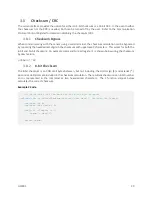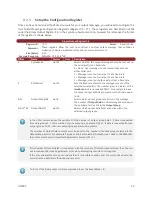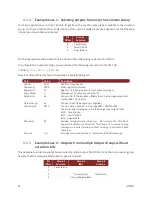
UM001
19
3.1.6
User Calibration
The VN-100 provides the user with the ability to apply a separate user calibration to remove additional
bias, scale factor, and axis misalignments. The user calibration is applied after the factory calibration, and
can be used to optionally fine tune the calibration for each of the individual sensors. The user calibration
is optional and in most cases not required for normal operation.
3.1.7
User Reference Frame Rotation
The user reference frame rotation provides the user with the ability to apply a rigid body rotation to each
of the sensor outputs. This can be used to transform the coordinate system of the onboard sensors into
any other coordinate frame of the user’s choice. Since this transformation is applied to the IMU
measurements prior to their use in the onboard attitude estimation algorithms, applying a user reference
frame rotation will not only change the output coordinates for the IMU measurements, it will also change
the IMU body frame for all subsequent attitude estimation calculations.
A write settings and reset command must be issued after setting the Reference Frame Rotation Register
before coordinate transformation will be applied.
3.1.8
User Low-Pass Filtering
The VN-100 also provides a means (see Register 85) to apply low-pass filtering to the output compensated
IMU measurements. It is important to note that the user low-pass filtering only applies to the output
compensated IMU measurements. All onboard Kalman filters in the NavFilter subsystem always use the
unfiltered IMU measurements after the User Reference Frame Rotation (Register 26) has been applied.
As such the onboard Kalman filtering will not be affected by the user low-pass filter settings. The user
low-pass filtering can be used to down-sample the output IMU measurements to ensure that information
is not lost when the IMU measurements are sampled by the user at a lower rate than the internal IMU
Rate.
3.1.9
Timestamp Measurements
All onboard measurements captured by the IMU subsystem are time stamped relative to several internal
timing events. These events include the monotonically increasing system time (time since startup), the
time since the last SyncIn event, and the time since the last GPS PPS pulse. These timestamps are recorded
with microsecond resolution and ~10 microsecond accuracy relative to the onboard temperature
compensated crystal oscillator. The onboard oscillator has a timing accuracy of ~20ppm over the
temperature range of -40C to 80C.
3.1.10
Coning & Sculling
The IMU subsystem is also responsible for computing and accumulating the coning and sculling integrals.
These integrals track the delta angle and delta velocity accumulated from one time step to another. The
coning and sculling integrals are reset each time the delta angle and/or delta velocity are outputted
(asynchronously) or polled from the delta theta and velocity register (Register 80). Between output and
polling events, the coning and sculling integration are performed by the IMU subsystem at the IMU Rate.






























